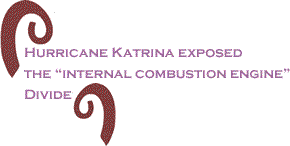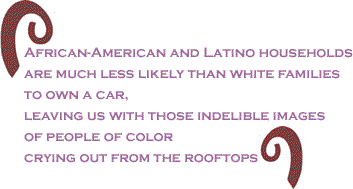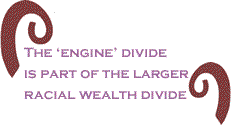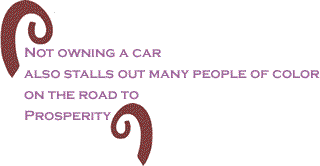
|
|||||||||||||||||||||
 |
|
Fifty years ago, the late Rosa Parks refused to give up her seat on a Montgomery, Alabama bus, catalyzing history-making events. Imagine, however, if Rosa Parks had lived in New Orleans in September 2005 and was trying to escape from the gathering clouds of Hurricane Katrina. Would she have jumped in her car? Would she have bought a train ticket? It is likely she wouldn't have found any bus seat. Would she have survived? In light of Hurricane Katrina, millions of Americans were forced to make such nerve-racking calculations. And their transportation options, unfortunately, depended on race. Those with cars largely escaped. But African-American and Latino households are much less likely than white families to own a car, leaving us with those indelible images of people of color crying out from the rooftops. A great deal of attention in the last two decades has been focused on the "digital divide," the concern that unequal access to new forms of technology such as the Internet are leaving people behind based on their class and race. But Hurricane Katrina exposed the "internal combustion engine" divide, the alarming disparity in car ownership that literally was the difference between life and death for many Gulf Coast residents.
A recent report on racial disparities in car ownership reveals that one in four Black households (24 percent) and one in six Latino households (17 percent) does not own a car. This is compared to one in fourteen white households (7 percent) who are car-less. In the eleven coastal counties with the highest incidence and future risk of hurricanes, people without cars are disproportionately people of color. These include counties in Houston, Providence, New Orleans, Tampa, New York City and Miami. In Orleans Parish New Orleans, for example, over 35 percent of African-Americans, 26 percent of Native Americans, and 27 percent of Latinos don't own a car, compared to 15 percent of whites. Emergency planning for Katrina and other preparedness efforts is heavily focused on traffic management for those who have cars. There are also some publicly funded emergency evacuation plans for people in institutions such as hospitals, nursing homes and mental health facilities. But there is inadequate planning for those who simply don't own cars. New Orleans had only one-quarter of the number of buses required to evacuate all its car-less residents. Beyond being able to save one's life, owning a car is often a stepping-stone toward job security and prosperity. Unfortunately, the invisible "engine" divide also influences a person's ability to find and retain a decent job. Without a car, many jobs are unreachable, and many small business ideas are unachievable. A growing number of jobs are located outside of urban centers on freeway beltways and in suburban communities, areas with weak or nonexistent public transportation.
The challenge for many people of color is not only owning a car, but having a dependable car. A twenty-year old car used for short city trips is not a dependable vehicle for a hundred-mile journey to higher ground or a 30 minute daily commute to a job in the suburbs. People of color tend to own cheaper and less dependable cars. Contrary to the stereotype of the Cadillac owning African American, at no time since 1992 has the median car value for people of color been even half as high as the value of cars owned by white families. Access to a vehicle is also essential for meeting the basic necessities of life, such as obtaining medical care or buying groceries, especially in rural areas. A recent national study by the Children's Health Fund found that lack of transportation was a leading factor in children missing doctor's appointments. Eleven percent of African-American families and 21 percent of Latino families missed out on medical care because of transportation issues, compared to only 2 percent of white families. Dependence on car ownership takes a big bite out of a family budget. Americans now spend 38 percent more on transportation than Europeans. For example, Detroit spends twice as much as Toronto on its roads and Toronto spent eight times more than Detroit on public transit. As a result, Detroit "motor city" residents spent more than twice as much as their Toronto counterparts on transportation, including the cost of car ownership and insurance, repairs and gas. The "engine" divide is rooted in two larger
problems: the bias toward the private automobile in transportation
planning and our nation's larger racial wealth gap. Over the last
century, But the "engine" divide is part of the larger racial wealth divide. Between 2001 and 2004, the median net worth of white families increased about 6 percent after inflation to $136,000, while the black median wealth remained unchanged at $20,000, according to the Federal Reserve. This racial wealth gap is the legacy of several centuries of public policies and private corporate practices that have encouraged white wealth ownership and disadvantaged wealth-building by people of color. In our zeal to promote an "ownership society" with broadened wealth and assets for low-income people, policy-makers have neglected the transportation piece of the puzzle. We need to recognize how access to dependable transportation is a fundamental step on the road to wealth-building. Owning a home in a new affordable suburban community that has inadequate public transportation further isolates families that don’t own private cars. For ecological and quality-of-life reasons, the answer is not necessarily to expand private automobile ownership. The cost of private car ownership is prohibitive for many low-income families. A growing number of communities already suffer from massive traffic congestion and many car users suffer from longer and longer daily commutes. More cars won't solve these problems.
Instead, communities need to focus on dependable public transportation systems and job creation closer to transportation hubs. A number of cities are encouraging business and job development closer to subway lines and rapid bus routes. For example, the District of Columbia has encouraged economic development on leased land near Metro stations that includes mixed-use retail and light industrial plants. This opens up jobs to car-less workers who have the option to walk, bike, bus or train to jobs, reducing traffic congestion and improving the overall quality of life. People of color bear an unfair share of the risks resulting from public policies that are biased toward car ownership. Given the present bias in our emergency planning, car ownership is a matter of life and death. But not owning a car also stalls out many people of color on the road to prosperity, closing the highway to jobs that require private transportation. These problems are solvable, but we must first see the invisible divides that exist around us. Hurricane Katrina not only dramatically revealed the grotesque racial and class divisions in our country, but also pointed to some obvious causes, such as our car dependent economy. An inclusive and dependable public transportation system should be at the top of the list. Meizhu Lui is the Executive Director of United for a Fair Economy and the co-author of the new report, "Stalling the Dream: Cars, Race and Hurricane Evacuation," available at www.faireconomy.org. |
|
| Home | |
Your comments are always welcome. Visit the Contact Us page to send e-Mail or Feedback or Click here to send e-Mail to [email protected] e-Mail re-print notice
If you send us an e-Mail message we may publish all or part of it, unless you tell us it is not for publication. You may also request that we withhold your name. Thank you very much for your readership. |
|
| January 19, 2006 Issue 167 |
||||||||||||||
|
||||||||||||||
|
||||||||||||||
| Printer Friendly Version in Plain Text or PDF format. Download free Adobe Reader. | ||||||||||||||
 |
||||||||||||||
 |
||||||||||||||
| |
||||||||||||||
| |
||||||||||||||































